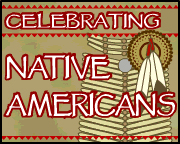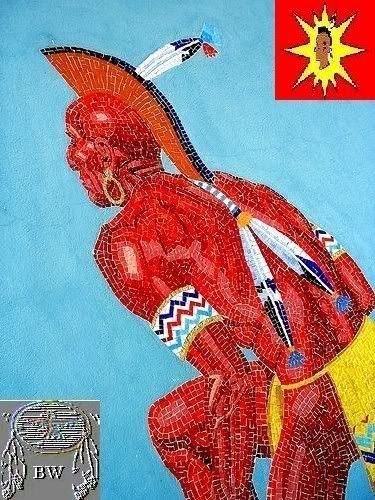|
BRAVEHORSE WARRIOR Karaghtadie
Mohawk Warrior

 Chief Karaghtadie
Warrior Citation
KARAGHTADIE (Karaghiagdatie, Kanaghkwase, Kuriahtaaty, Nicholas, Nickus), sachem of the Wolf clan of the Mohawks; probably
born in the early 1700s at Canajoharie (Indian Castle, Herkimer County, N.Y.) and probably died there in March 1759. Like
most Mohawks, Karaghtadie sided with the British against the French during the last two colonial wars. On 21 March 1747 he
received from William Johnson, who was in charge of Indian participation in these conflicts, provisions to take out a war
party. On 7 May 1747 Karaghtadie accompanied some 38 warriors headed by Theyanoguin. This expedition ended in disaster when
it was ambushed near Montreal in mid-June by French forces under Louis de La Corne and Jacques Legardeur de Saint-Pierre.
Karaghtadie and some 14 others were captured. He remained a prisoner in Canada, first with the French and then with the Indians,
probably the Hurons of Lorette, until August 1750. While a captive, Karaghtadie, hoping to get his release, invited his Mohawk
friends to come to Canada to confer with the French authorities about an exchange of prisoners. The French wished to negotiate
a separate peace with the Indians, as they had formerly done. The British, however, insisted on negotiating for all prisoners,
white and Native American, claiming in effect that the Native Americans were their subjects. Johnson managed to prevent a
delegation of several chiefs and Karaghtadie’s wife and family from leaving for Canada in 1749. Their going, he said,
would have been all that the French governor (Barrin de La Galissoničre) could have desired. When Karaghtadie returned home
in August 1750, after the French and English had finally reached agreement on the exchange of prisoners, he was angry and
upset at having been allowed to languish in captivity, and it took three days of hard work by Johnson to restore his good
humor. Though winning considerable respect from his white neighbours in his many dealings with them, Karaghtadie made a grave
mistake when in 1754 he was lured by John Hendricks L˙dius into signing a deed for land in the Wyoming valley of Pennsylvania.
This rash act, done without the consent of the Six Nations council, set off years of strife in the valley. Karaghtadie’s
wife, Sarah, appears to have been head woman of the Mohawks, for their son Hans became the Tekarihoken or head chief, an office
which descends through the female line. Sarah was not a woman to be taken lightly, even by her husband. In the summer of 1755,
when Karaghtadie was being urged by an agent of Major-General William Shirley to join an expedition against Fort Niagara (near
Youngstown, N.Y.), he hesitated. Finally he said, pointing to Sarah, “There is my wife . . . ask her Consent.”
The expedition against Niagara was cancelled, but on 8 Sept. 1755 many Mohawks, probably including Karaghtadie, took part
in the battle against Dieskau’s forces at Lake George (Lac Saint-Sacrement), and a son of Karaghtadie was killed there.
Chief Karaghtadie
Warrior Citation
KARAGHTADIE (Karaghiagdatie, Kanaghkwase, Kuriahtaaty, Nicholas, Nickus), sachem of the Wolf clan of the Mohawks; probably
born in the early 1700s at Canajoharie (Indian Castle, Herkimer County, N.Y.) and probably died there in March 1759. Like
most Mohawks, Karaghtadie sided with the British against the French during the last two colonial wars. On 21 March 1747 he
received from William Johnson, who was in charge of Indian participation in these conflicts, provisions to take out a war
party. On 7 May 1747 Karaghtadie accompanied some 38 warriors headed by Theyanoguin. This expedition ended in disaster when
it was ambushed near Montreal in mid-June by French forces under Louis de La Corne and Jacques Legardeur de Saint-Pierre.
Karaghtadie and some 14 others were captured. He remained a prisoner in Canada, first with the French and then with the Indians,
probably the Hurons of Lorette, until August 1750. While a captive, Karaghtadie, hoping to get his release, invited his Mohawk
friends to come to Canada to confer with the French authorities about an exchange of prisoners. The French wished to negotiate
a separate peace with the Indians, as they had formerly done. The British, however, insisted on negotiating for all prisoners,
white and Native American, claiming in effect that the Native Americans were their subjects. Johnson managed to prevent a
delegation of several chiefs and Karaghtadie’s wife and family from leaving for Canada in 1749. Their going, he said,
would have been all that the French governor (Barrin de La Galissoničre) could have desired. When Karaghtadie returned home
in August 1750, after the French and English had finally reached agreement on the exchange of prisoners, he was angry and
upset at having been allowed to languish in captivity, and it took three days of hard work by Johnson to restore his good
humor. Though winning considerable respect from his white neighbours in his many dealings with them, Karaghtadie made a grave
mistake when in 1754 he was lured by John Hendricks L˙dius into signing a deed for land in the Wyoming valley of Pennsylvania.
This rash act, done without the consent of the Six Nations council, set off years of strife in the valley. Karaghtadie’s
wife, Sarah, appears to have been head woman of the Mohawks, for their son Hans became the Tekarihoken or head chief, an office
which descends through the female line. Sarah was not a woman to be taken lightly, even by her husband. In the summer of 1755,
when Karaghtadie was being urged by an agent of Major-General William Shirley to join an expedition against Fort Niagara (near
Youngstown, N.Y.), he hesitated. Finally he said, pointing to Sarah, “There is my wife . . . ask her Consent.”
The expedition against Niagara was cancelled, but on 8 Sept. 1755 many Mohawks, probably including Karaghtadie, took part
in the battle against Dieskau’s forces at Lake George (Lac Saint-Sacrement), and a son of Karaghtadie was killed there.
 In 1758 Karaghtadie journeyed to Pennsylvania where, with other deputies of the Six Nations, he helped put down the
pretensions of Teedyuscung, a Delaware chief. Teedyuscung had denied the authority of the Iroquois over his tribe and at least
twice had seemed to turn to the French in order to advance his cause. In Easton, at a conference culminating on 23 October,
the Six Nations deputies made peace with Pennsylvania over the heads of their Delaware dependants, thus paving the way for
the fall of Fort Duquesne (Pittsburgh, Pa.) and British conquest of the west. Karaghtadie was a Christian, and at least one
of his children was baptized by an Anglican missionary, Henry Barclay. A daughter married George Croghan, the Pennsylvania
trader and Indian agent, and their daughter became the third wife of Joseph Brant [Thayendanegea]. From: historical accounts
& records
In 1758 Karaghtadie journeyed to Pennsylvania where, with other deputies of the Six Nations, he helped put down the
pretensions of Teedyuscung, a Delaware chief. Teedyuscung had denied the authority of the Iroquois over his tribe and at least
twice had seemed to turn to the French in order to advance his cause. In Easton, at a conference culminating on 23 October,
the Six Nations deputies made peace with Pennsylvania over the heads of their Delaware dependants, thus paving the way for
the fall of Fort Duquesne (Pittsburgh, Pa.) and British conquest of the west. Karaghtadie was a Christian, and at least one
of his children was baptized by an Anglican missionary, Henry Barclay. A daughter married George Croghan, the Pennsylvania
trader and Indian agent, and their daughter became the third wife of Joseph Brant [Thayendanegea]. From: historical accounts
& records
|

